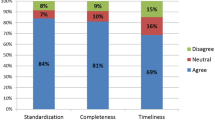Abstract
Background
This survey was conducted to determine the guidelines used by major medical centers in the United States for obtaining hospital privileges to interpret nuclear cardiology studies. The American College of Cardiology (ACC) and the American Society of Nuclear Cardiology (ASNC) have established guidelines to help maintain an adequate level of proficiency in the practice of nuclear cardiology. These guidelines were published only recently, and many hospitals have adopted different processes to obtain these privileges. It is likely that a marked difference among institutions exists.
Methods and Results
The survey was conducted predominantly by mailings with additional telephone communications if more information was needed. Chiefs of cardiovascular medicine sections were contacted to provide information concerning the policy of granting nuclear cardiology privileges at his or her institution. The responses were tabulated in four categories and the responders were asked to comment on whether they agreed or disagreed with their own university's policy. Of 80 responses (68%) from 121 institutions, cardiologists were involved in reading these studies in 62 (78%) and radiologists were the sole interpreters in 18 (22%). ACC or ASNC guidelines were strictly followed at 48 sites (60%). Eight (10%) and 6 (8%) of these institutions mandated a minimum requirement of, respectively, 12 and 6 months of additional training in nuclear cardiology. Ten (13%) of the cardiologists surveyed disagreed with their own institution's policies, primarily noting that the ACC and ASNC guidelines were more appropriate.
Conclusion
The recently established ACC/ASNC guidelines clearly have had an impact on the practice of attaining privileges in nuclear cardiology and are the most commonly quoted criteria used by institutions in the United States to assess competence in nuclear cardiology.
Similar content being viewed by others
References
Cerqueira MD, Shattuc S. Training and credentialing in nuclear cardiology: a fact sheet. American Society of Nuclear Cardiology 1994: 1–22.
Wackers FJT, van der Shoot JB, Busemann Sokole E, et al. Noninvasive visualization of acute myocardial infarction in man with thallium-201. Br Heart J 1975;37:741.
Ritchie JL, Gibbons RJ, Johnson LJ, Maddahi J, Schelbert HR, Wackers FJT, et al. Task Force 5: training in nuclear cardiology. J Am Coll Cardiol 1995;25(1):19–23.
Wackers FJT. Competence in nuclear cardiology: for the purpose of credentialing practicing nuclear cardiologists. American Society of Nuclear Cardiology 1994.
Zaret B, Battler A, Berger H, Bodenheimer M, Borer J, Brochier M, et al. Report of the Joint International Society and Federation of Cardiology/World Health Organization Task Force on Nuclear Cardiology. Circulation 1984;70:768A-81A.
DePuey E, Borer J, Brown K, Cequeira M, La Manna M, Moore M, et al. Cardiovascular nuclear medicine training guidelines. J Nucl Med 1994;35:169–78.
Educational update 1994: training programs in adult cardiology. J Am Coll Cardiol 1994;1146–66.
Ritchie JL, Gibbons RJ, Johnson LJ, Maddahi J, Schelbert HR, Wackers FJT, et al. Task Force 5: training in nuclear cardiology. J Am Coll Cardiol 1995;25(1):22.
US Nuclear Regulatory Commission Guides (35.920). Training for imaging and localization studies. Federal Registrar. Washington, DC: Superintendent of Documents, US Government Printing Office, 1994.
Cerqueira MD, Wackers FJT. The knowledge base for nuclear cardiology training. J Nucl Cardiol 1994;1:114–6.
Golub RJ, McClellan JR, Herman SD, Travin MI, Kline GM, et al. Effectiveness of nuclear training guidelines: a comparison of trainees with experienced readers. J Nucl Cardiol 1996;3(2):114–8.
Candidate Bulletin from the Certification Council of Nuclear Cardiology (CCNC). Certification Examination in Nuclear Cardiology. 1996.
Perneger TV, Etter JF, Rougemont A. Randomized trial of use of a monetary incentive and a reminder card to increase the response rate to a mailed health survey. Am J Epidemiol 1993;138(9):714–22.
Gilbert GH, Longmate J, Branch LG. Factors influencing the effectiveness of mailed health surveys. Public Health Rep 1992; 107(5):576–84.
Author information
Authors and Affiliations
Rights and permissions
About this article
Cite this article
Sorrell, V.L., Reeves, W.C. Who is interpreting nuclear cardiology studies in the United States, and what are the requirements for privileges? A national survey of institutional policies from 80 major medical centers. J Nucl Cardiol 4, 309–315 (1997). https://doi.org/10.1016/S1071-3581(97)90109-4
Received:
Accepted:
Issue Date:
DOI: https://doi.org/10.1016/S1071-3581(97)90109-4




